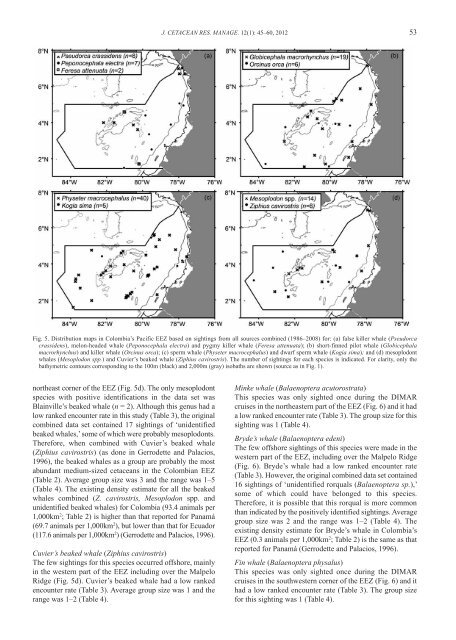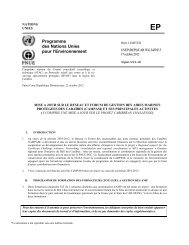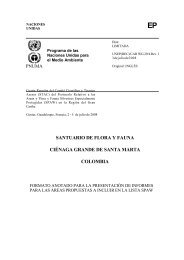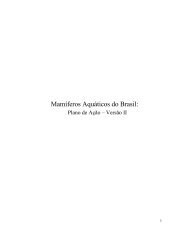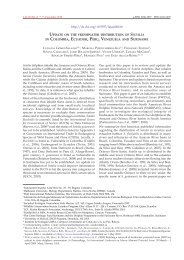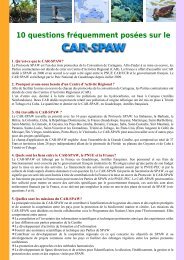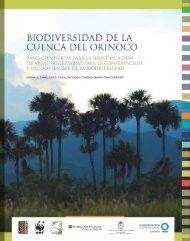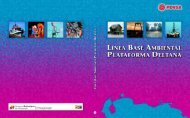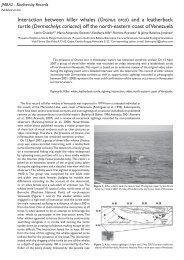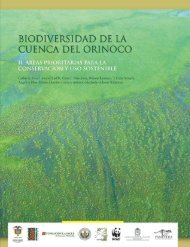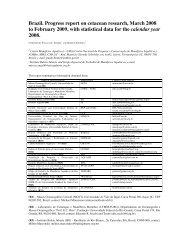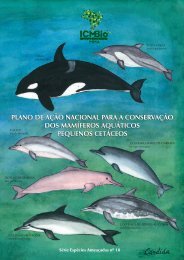Daniel M. Palacios et al. 2012. Cetacean distribution and relative ...
Daniel M. Palacios et al. 2012. Cetacean distribution and relative ...
Daniel M. Palacios et al. 2012. Cetacean distribution and relative ...
- No tags were found...
You also want an ePaper? Increase the reach of your titles
YUMPU automatically turns print PDFs into web optimized ePapers that Google loves.
J. CETACEAN RES. MANAGE. 12(1): 45–60, 2012 53Fig. 5. Distribution maps in Colombia’s Pacific EEZ based on sightings from <strong>al</strong>l sources combined (1986–2008) for: (a) f<strong>al</strong>se killer wh<strong>al</strong>e (Pseudorcacrassidens), melon-headed wh<strong>al</strong>e (Peponoceph<strong>al</strong>a electra) <strong>and</strong> pygmy killer wh<strong>al</strong>e (Feresa attenuata); (b) short-finned pilot wh<strong>al</strong>e (Globiceph<strong>al</strong>amacrorhynchus) <strong>and</strong> killer wh<strong>al</strong>e (Orcinus orca); (c) sperm wh<strong>al</strong>e (Phys<strong>et</strong>er macroceph<strong>al</strong>us) <strong>and</strong> dwarf sperm wh<strong>al</strong>e (Kogia sima); <strong>and</strong> (d) mesoplodontwh<strong>al</strong>es (Mesoplodon spp.) <strong>and</strong> Cuvier’s beaked wh<strong>al</strong>e (Ziphius cavirostris). The number of sightings for each species is indicated. For clarity, only thebathym<strong>et</strong>ric contours corresponding to the 100m (black) <strong>and</strong> 2,000m (gray) isobaths are shown (source as in Fig. 1).northeast corner of the EEZ (Fig. 5d). The only mesoplodontspecies with positive identifications in the data s<strong>et</strong> wasBlainville’s beaked wh<strong>al</strong>e (n = 2). Although this genus had <strong>al</strong>ow ranked encounter rate in this study (Table 3), the origin<strong>al</strong>combined data s<strong>et</strong> contained 17 sightings of ‘unidentifiedbeaked wh<strong>al</strong>es,’ some of which were probably mesoplodonts.Therefore, when combined with Cuvier’s beaked wh<strong>al</strong>e(Ziphius cavirostris) (as done in Gerrod<strong>et</strong>te <strong>and</strong> <strong>P<strong>al</strong>acios</strong>,1996), the beaked wh<strong>al</strong>es as a group are probably the mostabundant medium-sized c<strong>et</strong>aceans in the Colombian EEZ(Table 2). Average group size was 3 <strong>and</strong> the range was 1–5(Table 4). The existing density estimate for <strong>al</strong>l the beakedwh<strong>al</strong>es combined (Z. cavirostris, Mesoplodon spp. <strong>and</strong>unidentified beaked wh<strong>al</strong>es) for Colombia (93.4 anim<strong>al</strong>s per1,000km 2 ; Table 2) is higher than that reported for Panamá(69.7 anim<strong>al</strong>s per 1,000km 2 ), but lower than that for Ecuador(117.6 anim<strong>al</strong>s per 1,000km 2 ) (Gerrod<strong>et</strong>te <strong>and</strong> <strong>P<strong>al</strong>acios</strong>, 1996).Cuvier’s beaked wh<strong>al</strong>e (Ziphius cavirostris)The few sightings for this species occurred offshore, mainlyin the western part of the EEZ including over the M<strong>al</strong>peloRidge (Fig. 5d). Cuvier’s beaked wh<strong>al</strong>e had a low rankedencounter rate (Table 3). Average group size was 1 <strong>and</strong> therange was 1–2 (Table 4).Minke wh<strong>al</strong>e (B<strong>al</strong>aenoptera acutorostrata)This species was only sighted once during the DIMARcruises in the northeastern part of the EEZ (Fig. 6) <strong>and</strong> it hada low ranked encounter rate (Table 3). The group size for thissighting was 1 (Table 4).Bryde’s wh<strong>al</strong>e (B<strong>al</strong>aenoptera edeni)The few offshore sightings of this species were made in thewestern part of the EEZ, including over the M<strong>al</strong>pelo Ridge(Fig. 6). Bryde’s wh<strong>al</strong>e had a low ranked encounter rate(Table 3). However, the origin<strong>al</strong> combined data s<strong>et</strong> contained16 sightings of ‘unidentified rorqu<strong>al</strong>s (B<strong>al</strong>aenoptera sp.),’some of which could have belonged to this species.Therefore, it is possible that this rorqu<strong>al</strong> is more commonthan indicated by the positively identified sightings. Averagegroup size was 2 <strong>and</strong> the range was 1–2 (Table 4). Theexisting density estimate for Bryde’s wh<strong>al</strong>e in Colombia’sEEZ (0.3 anim<strong>al</strong>s per 1,000km 2 ; Table 2) is the same as thatreported for Panamá (Gerrod<strong>et</strong>te <strong>and</strong> <strong>P<strong>al</strong>acios</strong>, 1996).Fin wh<strong>al</strong>e (B<strong>al</strong>aenoptera phys<strong>al</strong>us)This species was only sighted once during the DIMARcruises in the southwestern corner of the EEZ (Fig. 6) <strong>and</strong> ithad a low ranked encounter rate (Table 3). The group sizefor this sighting was 1 (Table 4).


